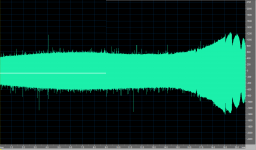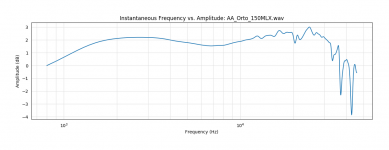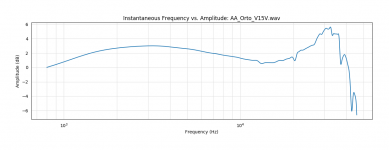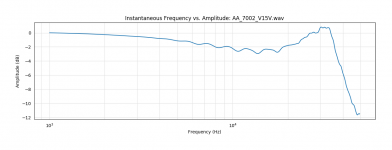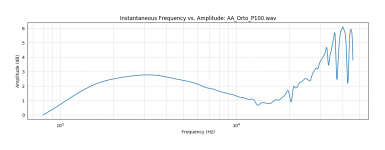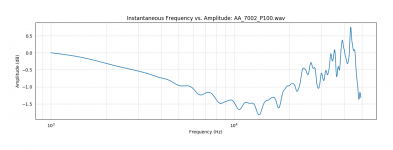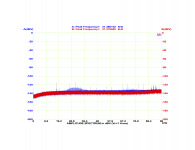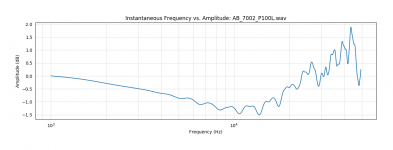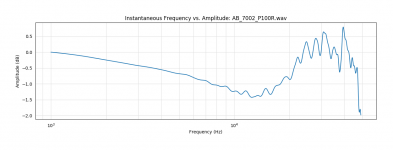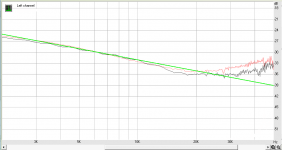JP could you post a picture of simply the envelope of the time domain signal on the Ortophon. We have been here before you can just eyeball the amplitude roughly with no processing.
JP,
Thankd for your .wav file and see it attached below processed by RMAA.
Very different from what I have, and deviation from the red line already starts at 20kHz ??
I wonder how that can be.
I have to search for the .wav file on my back-up because I had an unrepairable HD breakdown and send it tomorrow as promised.
Hans
Attachments
Yeah I agree, I came to the same result.Hans you can read it right off of the scale on the right, peak 1250 codes min 480 codes (approximately) 8.3dB difference.
It might not be the best LP on the world, but why can there be such a huge difference with my recording, it's a total mystery to me.
But as promised to JP, tomorrow I will send my .wav file.
Hans
No Problem, is it also O.K. for you Bill that I remove the stylus temporarily ?
Of course.
Possibly could be explained by FR of the cartridge used. JP has some cartridges that have 10-20% of the moving mass of your Benz. Under 20kHz this should not be noticed, but higher up yours may start rolling off before his.Yeah I agree, I came to the same result.
It might not be the best LP on the world, but why can there be such a huge difference with my recording, it's a total mystery to me.
But as promised to JP, tomorrow I will send my .wav file.
Hans
Of course.
Possibly could be explained by FR of the cartridge used. JP has some cartridges that have 10-20% of the moving mass of your Benz. Under 20kHz this should not be noticed, but higher up yours may start rolling off before his.
But my Cart doesn’t roll off, it’s straight within 1dB up to 45kHz on the 45rpm Ortofon record, just as it is with the CH Precision at 61rpm.
Two completely different records giving the same results !!
Hans
This is where the fun starts and we need to use the coast down method to extract actual FR from the same groove spun at different speed 🙂
Hmm. I took the phono stage down to ~150pF, but I need to verify that. At any rate, same setting I used on the first 1-50kHz sweep with the P100CMK4. Since that sweep I did change the XLR to mini XLR on my arm cable, as I converted an SH-305 SUT to balanced with mini XLR.
Attachments
Hmm. I took the phono stage down to ~150pF, but I need to verify that. At any rate, same setting I used on the first 1-50kHz sweep with the P100CMK4. Since that sweep I did change the XLR to mini XLR on my arm cable, as I converted an SH-305 SUT to balanced with mini XLR.
Could you by any chance show the noise spectrum from your straight amp up to >50 kHz with the Cart connected, but arm in the air ?
Hans
Well, I think that when all useful and relevant info's from these Carts are extracted satisfactory, testing ends here, unless someone still has some wish that I can possibly realise.
If I have read this right then we have evidence that laminated or split pin cartridges do have benefits in terms of impedance stability in the audio band.
Transamp MM stages work best with said laminated constructions.
We have no evidence of impedance of the coil changing significantly with level.
We also don't have a clear mechanism for the midband dip some MMs show with certain preamps although it could still be the test record.
So moving forwards we need to now get some measurements off test records to try and tally things up.
I would be interested also if it we can work out if the very low Z cartridges have any real benefits. Other than Grado they have all died out in the early 80s which suggests the benefits were outweighed by the disadvantages (2mV output for a start).
Every time I think we have a good handle on what causes the FR of a MM cartridge something comes along to confuse me again 🙂.
I've an early 1900's waffle iron to season.
One that flips on its base? We have one that has a playing card motif as the pattern (each suit in one quadrant) a rare find $15 before they went viral.
Yes - Griswold New American no 8. Got it off eBay. Seller ‘seasoned’ with I don’t know how many gallons of oil, so it all had to come off to be done right.
The mid Z cartridges like Grados would have worked far better with a more suitable preamplifier with 10k or so input resistance and a more optimised input noise behaviour. Standardisation on 47k with noisy jfet or even cmos opamps was incompatibleI would be interested also if it we can work out if the very low Z cartridges have any real benefits. Other than Grado they have all died out in the early 80s which suggests the benefits were outweighed by the disadvantages (2mV output for a start).
Every time I think we have a good handle on what causes the FR of a MM cartridge something comes along to confuse me again 🙂.
I was thinking more of if they are more suited to transamp operation. The Grados are extreme but panasonic and AT did sub 100mH carts in the 70s.
JP,
Here are as promised the .wav files of both channels.
Image below shows the deviation from 2kHz up to 50kHz from L (black) and R channel (red) from the straight 0dB line (blue).
It is obvious that the R channel has a flatter FR. Maybe what you showed was the L channel.
Would be interesting to see both channels from you too.
Dropbox - 45rpmOrtofon-1.wav - Simplify your life
Dropbox - Orto45-1.wav - Simplify your life
Hans
Here are as promised the .wav files of both channels.
Image below shows the deviation from 2kHz up to 50kHz from L (black) and R channel (red) from the straight 0dB line (blue).
It is obvious that the R channel has a flatter FR. Maybe what you showed was the L channel.
Would be interesting to see both channels from you too.
Dropbox - 45rpmOrtofon-1.wav - Simplify your life
Dropbox - Orto45-1.wav - Simplify your life
Hans
Attachments
- Status
- Not open for further replies.
- Home
- Source & Line
- Analogue Source
- Cartridge dynamic behaviour
